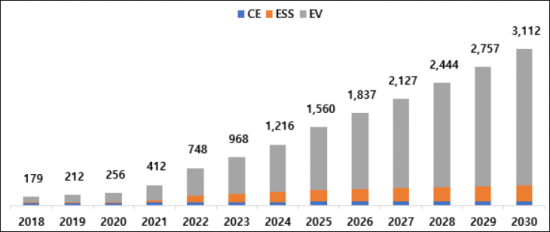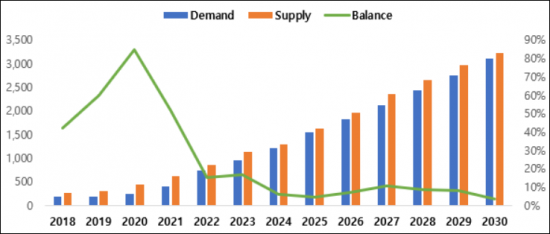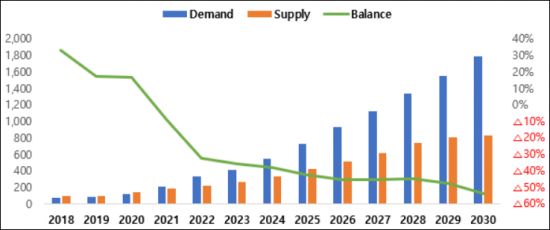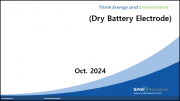
|
시장보고서
상품코드
1343611
<2023> 리튬이온 2차전지 전해액 기술동향 및 시장전망 (-2030)<2023> Lithium-Ion Battery Electrolyte Technology Trends and Market Forecast (~2030) |
||||||
최근 이차전지 시장은 소형 IT용 Application 시장에서 ESS, 전기차 시장으로 시장을 확대해 나가고 있습니다. 이차전지를 개발하고 산업을 개척했던 일본의 기존 업체인 일본의 Panasonic 등은 한국의 강자 LGES 등과의 시장 경쟁에서 밀리고 있고 중국의 업체인 CATL, BYD, CALB 등이 중국 정부의 지원과 무한한 내수 시장을 발판으로 M/S를 더욱 확장하고 있습니다. 당분간 한, 중, 일 “이차전지 삼국 구도”는 지속될 것으로 예상되지만, 전기차 시장의 확대에 따른 북미와 유럽 역시 대용량 이차전지 제조 및 재료시장에 지속적으로 관심을 보이고 있습니다. 특히 IRA와 같은 각국의 정책 및 규제로 인해 이차전지 시장에 큰 지형 변화가 있을 것으로 예상됩니다.
전해액을 살펴보면 크게 용매(Solvents), 리튬염 (Lithium Salt), 첨가제(Additives)로 구성되어 있습니다.전해액은 제품의 특성상 리튬이온 이차전지 제조 업체와 공동으로 개발을 진행 하게 됩니다. IT형 소형 제품의 경우 짧게는 3-4개월 개발 기간이 소요되고 xEV용 전해액은 1년이 넘게 제품을 개발과 평가를 진행하게 됩니다. 다양한 제품을 고객의 니즈에 맞추어 개발 대응하기 위해서는 우수한 R&D 능력이 요구됩니다.
과거 전해액 시장은 일본과 한국이 주축이 되었으나, 최근 중국 업체들의 비약적인 성장으로 시장점유율 Top3를 모두 중국 업체가 차지한 실정입니다. 국내의 경우 전해액을 양산 공급하고 있는 동화일렉트로라이트와 솔브레인, 엔켐 등은 리튬이온 이차전지 주요 3사(삼성SDI, LG에너지솔루션, SK온)와 동반하여 전해액 공급업체로써 같이 성장할 수 있었습니다. 일본의 경우 Mitsubishi Chemical이 IT 소형, xEV 중대형 전지를 생산하는 고객의 Portfolio를 다양화하였습니다. 중국 업체로는 Tinci, Guotai-Huarong, Capchem 등이 시장을 지배하고 있습니다.
전해액의 주요한 성분인 리튬염(LiPF6)는 과거 일본 업체가 대부분을 공급했으나, 현재 중국 업체들이 CAPA를 증설하면서 판도가 바뀌게 되었습니다. 한국의 경우 후성이 범용 리튬염(LiPF6)을, 천보가 특수 리튬염(LiFSI, LiPO2F2, LiDFOP, LiBOB)을 양산 공급하고 있다. 첨가제(Additives)는 SEI 보호막 형성과 과충전 방지제, 전도특성 향상 등 리튬이온 이차전지의 수명과 안정성을 향상을 위해 전해액을 제조하는 과정에서 첨가되게 됩니다. 일본 업체가 첨가제 시장의 대부분을 점유하고 있고 한국에서는 천보, 켐트로스 등이 공급하고 있습니다.
전해액은 이차 전지를 구성하는 4대 핵심 소재 중 하나입니다. 일반적인 리튬이온 전지의 제조원가 구성에서 비중을 따지면 양극재 > 분리막 > 음극재 > 전해액 순서입니다. 이차전지 제조 업체의 단위 셀 당 에너지밀도를 증가시키기 위해 양극재, 음극재 재료 투입량을 늘리고 있는 추세이며. 상대적으로 전해액 투입량을 줄이고 있습니다. 하지만 2022년부터 2030년까지 배터리 시장은 연평균 약 23%(용량기준) 내외로 증가할 전망입니다. 이에 따른 전해액 시장 성장이 기대됩니다.
전기차 및 ESS 용도의 대용량 이차전지에는 전해액 사용량이 IT용에 비해 단위셀 기준으로 약 200배 - 4,000배까지 늘기 때문에 특히 안정성 확보가 매우 중요한 이슈로 대두되고 있습니다. 현재 상용화 되어 있는 액체 전해질, 겔 고분자 전해질 (폴리머) 이외에 고온 안정성이 우수한 고체 고분자 전해질 및 전고체 세라믹 전해질 개발에 지속적인 연구 개발을 진행 중 입니다.
본 리포트에서 당사는 리튬이온 이차전지에 적용하기 위한 전해액 완제품 및 각 구성재료에 대한 기술적 정보를 상세하게 정리하였으며, 당사의 다양한 전망자료를 기초로 바인더에 대한 수요 및 시장을 전망하여 독자들이 전체적인 규모를 파악하는데 도움을 주고자 하였습니다.
마지막으로, 주요 배터리 제조업체의 전해액 수요 및 전해액 업체들의 공급 현황과 전망을 정리함으로써 이 분야의 연구자 및 관심있는 분들에게 기술부터 시장에 이르는 넓은 범위의 통찰력을 제공하고자 노력하였습니다.
본 보고서의 Strong Point
- 1. 전해액 완제품 및 구성재료에 대한 전반적인 개요 및 기술 정보 수록
- 2. 기존 LIB 외의 차세대 전지에 적용될 고체 및 고분자 전해질에 대한 소개
- 3. 당사의 전망자료에 근거한 전해액 시장전망을 통해 객관적인 데이터 제공
- 4. 한,중,일 주요 전해액 Player의 제품 및 생산 현황에 대한 상세한 정보 수록
[목 차]
리포트 개요
Chapter Ⅰ. 전해액 개요
- 1.1 전해액에 대한 이해
- 1.2 전해액 개발 동향 및 주요 이슈
Chapter Ⅱ. 액체 전해질의 개발 동향
- 2.1 액체 전해질의 구성
- 2.2 액체 전해질의 특성
- 2.3 난연소재
Chapter Ⅲ. 고분자 전해질의 개발 동향
- 3.1 고분자 전해질의 종류
- 3.2 고분자 전해질의 특성
- 3.3 고분자 전해질의 제조법
Chapter Ⅳ. 고체 전해질
- 4.1 고체 전해질 개발 필요성
- 4.2 고체 전해질의 종류 및 기술적 특성
- 4.3 고체 전해질의 개발 동향
Chapter Ⅴ. 전해액 최신 개발 동향
- 5.1 고전압 전해액 용매
- 5.2 리튬염
- 5.3 첨가제
- 5.4 고분자 전해질
Chapter Ⅵ. 전해액 용매
- 6.1 환형 카보네이트
- 6.2 선형 카보네이트
- 6.3 전극 표면 보호피막 형성용 첨가제에 의한 가스 발생 메커니즘
Chapter Ⅵ. 전해액 용매
- 6.1 환형 카보네이트
- 6.2 선형 카보네이트
- 6.3 전극 표면 보호피막 형성용 첨가제에 의한 가스 발생 메커니즘
Chapter Ⅶ. 전해액 첨가제
- 7.1 High-Ni계 양극 계면 안정화를 위한 전해액 첨가제
- 7.2 출력 특성 향상을 위한 전해액 첨가제
- 7.3 LiFSI 염을 사용하는 전해액
- 7.4 열안정성 향상을 위한 난연성 첨가제
- 7.5 고용량 음극 계면 안정화를 위한 첨가제
Chapter Ⅷ-1. 전해액 시장 동향 및 전망
- 8.1.1 국가별 전해액 사용량 현황
- 8.1.2 용도별 전해액 사용량 현황
- 8.1.3 공급 업체별 시장 현황
- 8.1.4 LIB 업체별 전해액 수요 현황
- (SDI/LGES/SKon/Panasonic/CATL/ATL/BYD/Lishen/Guoxuan(Gotion)/AESC)
- 8.1.5 전해액 수요 전망
- 8.1.6 전해액 CAPA 및 수급 전망
- 8.1.7 전해액 가격 동향
- 8.1.8 전해액 시장 규모 전망
Chapter Ⅷ-2. 전해액 소재별 현황
- 8.2.1 범용 리튬염 (LiPF6)
- 8.2.2 非 LiPF6 리튬염
- 8.2.3 기능성 첨가제
Chapter Ⅸ. 전해액 생산업체 현황
- 9.1 한국 전해액 업체
- Dongwha Electrolyte / Soulbrain / Enchem / Foosung / Chunbo / Chemtros
- 9.2 일본 전해액 업체
- Mitsubishi / Ube / Centralglass / Tomiyama / MUIS / Nippon Shokubai
- 9.3 중국 전해액 업체
- Tinci / Capchem / Guotai Huarong / Shanshan / Jinniu / DFD / Shinghwa
Recently, the secondary battery market has expanded from small IT applications to ESS and electric vehicles. Japanese companies such as Panasonic, which developed secondary batteries and pioneered the industry, are losing out to Korean powerhouses such as LGES, while Chinese companies such as CATL, BYD, and CALB are further expanding their M/S with the support of the Chinese government and an unlimited domestic market. Although the Korean, Chinese, and Japanese "trilateral system" is expected to continue for the foreseeable future, North America and Europe are also showing continued interest in the large-capacity secondary battery manufacturing and materials market due to the expansion of the electric vehicle market. In particular, the policies and regulations of each country, such as the IRA, are expected to significantly change the landscape of the secondary battery market.
The electrolyte is mainly composed of solvents, lithium salts, and additives. Depending on the nature of the product, the electrolyte will be developed in collaboration with lithium-ion secondary battery manufacturers. For small IT-type products, the development period is as short as three to four months, while electrolytes for xEVs are developed and evaluated for more than a year. Excellent R&D capabilities are required to develop and respond to various products according to customer needs.
In the past, the electrolyte market was dominated by Japan and South Korea, but with the recent rapid growth of Chinese companies, the top three market shares have been taken over by Chinese companies. In Korea, Donghwa Electrolyte, Soulbrain, and Enchem have been able to grow together as electrolyte suppliers with the three major lithium-ion secondary battery companies (Samsung SDI, LG Energy Solution, and SK energy). In Japan, Mitsubishi Chemical has diversified its portfolio of customers producing IT small, xEV medium and large cells. In China, Tinci, Guotai-Huarong, and Capchem dominate the market.
Lithium salts (LiPF6), the main ingredient of electrolyte, have been mostly supplied by Japanese companies in the past, but the game has changed as Chinese companies have increased their CAPA. In South Korea, Foosung provides general-purpose lithium salts (LiPF6), while Chunbo mass-produces specialized lithium salts (LiFSI, LiPO2F2, LiDFOP, LiBOB). Additives are added during the electrolyte manufacturing process to improve the lifespan and stability of Li-ion secondary batteries, such as SEI protection, overcharge prevention agents, and conductive properties. While Japanese companies dominate the additives market, in Korea Chunbo and Chemtros are among the main suppliers.
Electrolyte is one of the four key materials that make up a secondary battery. In the manufacturing cost composition of a typical Li-ion battery, the order of importance is anode material > separator > cathode material > electrolyte. To increase the energy density per unit cell, secondary battery manufacturers are increasing the input of anode and cathode materials, while reducing the input of electrolyte. However, from 2022 to 2030, the battery market is expected to grow at an average annual rate of around 23% (by capacity). The electrolyte market is expected to grow accordingly.
For large-scale rechargeable batteries for electric vehicles and ESS, the amount of electrolyte used is about 200 times to 4,000 times higher on a unit cell basis than for IT, so securing stability is becoming a particularly important issue. In addition to liquid electrolytes and gel polymer electrolytes (polymers) that are currently commercialized, research and development is underway to improve the stability of solid polymer electrolytes and all-solid ceramic electrolytes with excellent high temperature stability.
This report provides detailed technical information on finished electrolyte products and their components for application in lithium-ion secondary batteries and forecasts the demand and market for binders based on our various forecasts to help readers understand the overall scale.
Finally, by summarizing the electrolyte demand of major battery manufacturers and the supply status and outlook of electrolyte companies, the report aims to provide researchers and interested parties in this field with a wide range of insights from technology to market.
Strong points of this report:
- 1. overall overview and technical information on electrolyte finished products and components
- 2. Introduction to solid and polymer electrolytes that will be applied to next-generation batteries other than conventional LIBs
- 3. Provides objective data on the electrolyte market outlook based on our forecast data
- 4. Detailed information on the product and production status of major electrolyte players in Korea, China, and Japan
<Global Electrolytes Market Demand Forecas (~2030)>

*Based on SNE battery demand forecasts.
<Global Electrolyte Supply and Demand Outlook (2018~2030)>

<Electrolyte Supply and Demand Outlook for Non-Chinese Markets (2018~2030)>

*Except for Chinese market supply and demand.
Table of Contents
Outline of Report
Chapter I. Electrolyte Overview
- 1.1. Understanding of electrolytes
- 1.2. Development trends and major issues of electrolytes
Chapter II. Development Trend of Liquid Electrolytes
- 2.1. Composition of liquid electrolytes
- 2.2. Characteristics of liquid electrolytes
- 2.3. Flame retardant material
Chapter III. Development Trend of Polymer Electrolyte
- 3.1. Types of polymer electrolytes
- 3.2. Characteristics of polymer electrolytes
- 3.3. Manufacturing method of polymer electrolytes
Chapter IV. Solid Electrolytes
- 4.1. Necessity for development of solid electrolytes
- 4.2. Types and technical characteristics of solid electrolytes
- 4.3. Development trends of solid electrolytes
Chapter V. Latest Development Trends of Electrolytes
- 5.1. High voltage electrolyte solvents
- 5.2. Lithium salts
- 5.3. Additives
- 5.4. Polyelectrolytes
Chapter VI. Electrolyte Solvents
- 6.1. Cyclic carbonate
- 6.2. Linear carbonate
- 6.3. Gas generation mechanism by additives for forming the protective film on the electrode surface
Chapter VII. Electrolyte Additives
- 7.1. Electrolyte additives for high-Ni cathode interface stabilization
- 7.2. Electrolyte additives for improved output characteristics
- 7.3. Electrolytes using LiFSI salts
- 7.4. Flame retardant additives for improved thermal stability
- 7.5. Additives for high-capacity anode interface stabilization
Chapter VIII-1. Electrolyte Market Trends and Outlook
- 8.1.1. Electrolyte demand by country
- 8.1.2. Electrolyte usage by application
- 8.1.3. Market status by suppliers
- 8.1.4. Electrolyte demand by LIB companies
- (SDI/LGES/SKon/Panasonic/CATL/ATL/BYD/Lishen/Guoxuan(Gotion)/AESC)
- 8.1.5. Electrolyte demand outlook
- 8.1.6. Electrolyte CAPA and supply & demand outlook
- 8.1.7. Electrolyte price trends
- 8.1.8. Electrolyte market size forecast
Chapter VIII-2. Electrolyte Material Status
- 8.2.1. General lithium salts (LiPF6)
- 8.2.2. Non-LiPF6 lithium salts
- 8.2.3. Functional additives
Chapter IX. Electrolyte Manufacturer Status
- 9.1. Korean electrolyte companies
- Dongwha Electrolyte / Soulbrain / Enchem / Foosung / Chunbo / Chemtros
- 9.2. Japanese electrolyte companies
- Mitsubishi / Ube / Centralglass / Tomiyama / MUIS / Nippon Shokubai
- 9.3. Chines electrolyte companies
- Tinci / Capchem / Guotai Huarong / Shanshan / Jinniu / DFD / Shinghwa
(주말 및 공휴일 제외)












